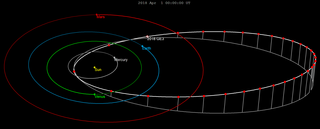Timeline of close approaches less than one lunar distance from Earth in 2009
A list of known near-Earth asteroid close approaches less than 1 lunar distance (384,400 km or 0.00256 AU) from Earth in 2009. [note 1]
Rows highlighted red indicate objects which were not discovered until after closest approach
Rows highlighted yellow indicate objects discovered less than 24 hours before closest approach
Rows highlighted green indicate objects discovered more than one week before closest approach
Rows highlighted turquoise indicate objects discovered more than 7 weeks before closest approach
Rows highlighted blue indicate objects discovered more than one year before closest approach (i.e.
objects successfully cataloged on a previous orbit, rather than being detected during final approach)
This list does not include any of the objects that collided with earth in 2009, none of which were discovered in advance, but were recorded by sensors designed to detect detonation of nuclear devices.
| Date of closest approach | Date discovered | Object | Nominal geocentric distance (AU) [note 2] | Nominal geocentric distance (LD) | Size (m) (approximate) | (H) (abs. mag) | Closer approach to Moon | Refs [1] [2] |
|---|---|---|---|---|---|---|---|---|
| 2009-02-02 | 2009-02-04 | 2009 CC2 | 0.00123 AU (184,000 km; 114,000 mi) | 0.48 | 7.3–16 | 27.8 | data · 2009 CC2 | |
| 2009-02-27 | 2009-03-03 | 2009 EJ1 | 0.00041 AU (61,000 km; 38,000 mi) | 0.16 | 5.6–12 | 28.4 | data · 2009 EJ1 | |
| 2009-03-02 | 2009-02-27 | 2009 DD45 | 0.00048 AU (72,000 km; 45,000 mi) | 0.19 | 18–41 | 25.8 | data · 2009 DD45 | |
| 2009-03-06 | 2009-03-02 | 2009 EW | 0.00227 AU (340,000 km; 211,000 mi) | 0.88 | 14–31 | 26.4 | data · 2009 EW | |
| 2009-03-18 | 2009-03-17 | 2009 FH | 0.00057 AU (85,000 km; 53,000 mi) | 0.22 | 13–28 | 26.6 | data · 2009 FH | |
| 2009-03-19 | 2009-03-17 | 2009 FK | 0.00250 AU (374,000 km; 232,000 mi) | 0.97 | 5.8–13 | 28.3 | Yes | data · 2009 FK |
| 2009-05-05 | 2009-05-04 | 2009 JF1 | 0.00196 AU (293,000 km; 182,000 mi) | 0.76 | 10–23 | 27.1 | Yes | data · 2009 JF1 |
| 2009-05-13 | 2009-05-12 | 2009 JL2 | 0.00177 AU (265,000 km; 165,000 mi) | 0.69 | 17–38 | 26.0 | data · 2009 JL2 | |
| 2009-06-01 | 2009-05-31 | 2009 KR21 | 0.00190 AU (284,000 km; 177,000 mi) | 0.74 | 12–27 | 26.7 | Yes | data · 2009 KR21 |
| 2009-10-01 | 2009-10-02 | 2009 TB | 0.00046 AU (69,000 km; 43,000 mi) | 0.18 | 3.8–8.6 | 29.2 | data · 2009 TB | |
| 2009-10-05 | 2009-10-09 | 2009 TD17 | 0.00173 AU (259,000 km; 161,000 mi) | 0.67 | 7.7–17 | 27.7 | data · 2009 TD17 | |
| 2009-10-08 | 2009-10-10 | 2009 TU | 0.00204 AU (305,000 km; 190,000 mi) | 0.79 | 9.2–21 | 27.3 | data · 2009 TU | |
| 2009-10-17 | 2009-10-15 | 2009 TM8 | 0.00232 AU (347,000 km; 216,000 mi) | 0.90 | 5.6–12 | 28.4 | data · 2009 TM8 | |
| 2009-11-06 | 2009-11-06 | 2009 VA | 0.00014 AU (21,000 km; 13,000 mi) | 0.05 | 5.1–11 | 28.6 | data · 2009 VA | |
| 2009-11-12 | 2009-11-10 | 2009 VZ39 | 0.00174 AU (260,000 km; 162,000 mi) | 0.68 | 6.5–14 | 28.1 | Yes? [note 3] | data · 2009 VZ39 |
| 2009-11-15 | 2009-11-18 | 2009 WP6 | 0.00176 AU (263,000 km; 164,000 mi) | 0.69 | 12–26 | 26.8 | data · 2009 WP6 | |
| 2009-11-16 | 2009-11-18 | 2009 WQ6 | 0.00235 AU (352,000 km; 218,000 mi) | 0.91 | 3.8–8.6 | 29.2 | data · 2009 WQ6 | |
| 2009-11-20 | 2009-11-19 | 2009 WJ6 | 0.00119 AU (178,000 km; 111,000 mi) | 0.46 | 8.8–20 | 27.4 | data · 2009 WJ6 | |
| 2009-11-24 | 2009-11-23 | 2009 WV51 | 0.00101 AU (151,000 km; 94,000 mi) | 0.39 | 10–23 | 27.1 | data · 2009 WV51 |
Warning Times by Size
This table visualizes the warning times of the close approaches listed in the above table, depending on the size of the asteroid. The sizes of each pie chart show the relative sizes of the asteroids to scale. For comparison, the approximate size of a person is also shown. This is based around the absolute magnitude of each asteroid, an approximate measure of size based on brightness.
| Comments | Relative Size |
|---|---|
(size of a person for comparison) | |
Absolute Magnitude 29-30 | |
Absolute Magnitude 28-29 | |
Absolute Magnitude 27-28 | |
Absolute Magnitude 26-27 | |
Absolute Magnitude 25-26 (Largest) |
Notes
- ↑ For a list of current Earth close approaches see NEO Earth Close Approaches
- ↑ Distance from the center of Earth to the center of the object. See the NASA/JPL Solar System Dynamics Glossary: Geocentric. Earth has a radius of approximately 6,400 km.
- ↑ The orbit of 2009 VZ39 is known quite poorly- it could have passed as closely as 0.029 and as far as 3.1 LD from Earth, as well as anything from 3.4 LD to colliding head-on with the Moon. As such, the values are based on the nominal calculations. Considering a fireball would likely be noticed if it had collided with the Moon, as it would have created a crater over 150 meters in diameter, it can probably be concluded that the actual orbit was not too far from the nominal one- with a closest approach somewhere between 0.5 and 0.8 lunar distances.






